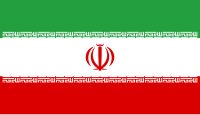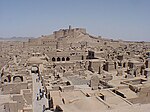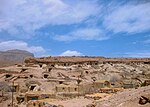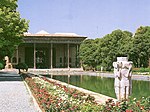List of World Heritage Sites in Iran



The United Nations Educational, Scientific and Cultural Organization (UNESCO) World Heritage Sites are places of importance to cultural or natural heritage as described in the UNESCO World Heritage Convention, established in 1972.[1] Iran accepted the convention on 26 February 1975, making its historical sites eligible for inclusion on the list. As of 2016, twenty-one sites in Iran are included[2]
The first three sites in Iran, Meidan Emam, Esfahan, Persepolis and Tchogha Zanbil, were inscribed on the list at the 3rd Session of the World Heritage Committee, held in Paris, France in 1979.[3] They remained the Islamic Republic's only listed properties until 2003, when Takht-e Soleyman was added to the list.[4] The latest additions were The Persian Qanat and Lut Desert, both inscribed in 2016, the latter being Iran's first site selected for its natural significance.[5][6]
In addition to its inscribed sites, Iran also lists forty-one properties on its tentative list.[7]
Inscribed sites
The table is sortable by column by clicking on the ![]() at the top of the appropriate column; alphanumerically for the Site, Area, and Year columns; by state party for the Location column; and by criteria type for the Criteria column. Transborder sites sort at the bottom.
at the top of the appropriate column; alphanumerically for the Site, Area, and Year columns; by state party for the Location column; and by criteria type for the Criteria column. Transborder sites sort at the bottom.
- Site; named after the World Heritage Committee's official designation[8]
- Location; at city, regional, or provincial level and geocoordinates
- Criteria; as defined by the World Heritage Committee[9]
- Area; in hectares and acres. If available, the size of the buffer zone has been noted as well. A lack of value implies that no data has been published by UNESCO
- Year; during which the site was inscribed to the World Heritage List
- Description; brief information about the site, including reasons for qualifying as an endangered site, if applicable
Tentative list
In addition to sites inscribed on the World Heritage list, member states can maintain a list of tentative sites that they may consider for nomination. Nominations for the World Heritage list are only accepted if the site was previously listed on the tentative list.[29] As of July 2017, Iran lists forty-eight properties on its tentative list:[7]
- Jame' (Congregational) Mosque of Esfahan
- Historic ensemble of Qasr-e Shirin (1997)
- Firuzabad Ensemble
- Shush
- Nasqsh-e Rostam and Naqsh-e Rajab
- Tape Sialk
- The Ensemble of Historical Sassanian Cities in Fars Province (Bishabpur, Firouzabad, Sarvestan)
- Taq-e Bostan
- Kuh-e Khuaja
- Persepolis and Other Televant Buildings
- The Historical–Cultural Axis of Fin, Sialk, Kashan
- Historical Ensemble of Qasr-e Shirin (2007)
- Historic Monument of Kangavar
- The Historical City of Maybod
- The Historical Port of Siraf
- Bazaar of Qaisariye in Laar
- The Historical Village of Abyaneh
- Bastam and Kharghan
- The Historical Texture of Damghan
- The Cultural-Natural Landscape of Ramsar
- Kaboud Mosque
- Tous Cultural Landscape
- The Historical City of Masouleh
- The Complex of Izadkhast
- Cultural Landscape of Alamout
- Qanats of Gonabad
- Zozan
- Khorramabad Valley
- Jiroft
- Ghaznavi-Seljukian Axis in Khorasan
- The Cultural Landscape of Uramanat
- Hyrcanian Forest (Caspian Forest)
- Qeshm Island
- Lut Desert (the vicinity of Shahdad)
- Arasbaran Protected Area
- Sabalan
- Khabr National Park and Ruchun Wildlife Refuge
- Alisadr Cave
- Silk Route (Also as Silk Road)
- The Natural-Historical Landscape of Izeh
- The Zandiyeh Ensemble of Fars Province
- Kerman Historical-Cultural Structure
- Hegmataneh
- The Collection of Historical Bridges
- Touran Biosphere Reserve
- Hamoun Lake
- Harra Protected Area
- Damavand
Location of sites
References
- ^ "The World Heritage Convention". UNESCO. Retrieved 21 September 2010.
- ^ "Iran". UNESCO. Retrieved 10 August 2016.
- ^ "Report of the 3rd Session of the Committee". UNESCO. Retrieved 10 August 2016.
- ^ "Report of the 27th Session of the Committee". UNESCO. Retrieved 10 August 2016.
- ^ a b "The Persian Qanat". UNESCO. Retrieved 7 August 2016.
- ^ a b "Lut Desert". UNESCO. Retrieved 7 August 2016.
- ^ a b "Tentative List – Iran". UNESCO. Retrieved 10 August 2016.
- ^ "World Heritage List". UNESCO. Retrieved 28 May 2010.
- ^ "The Criteria for Selection". UNESCO. Retrieved 10 September 2011.
- ^ "Armenian Monastic Ensembles of Iran". UNESCO. Retrieved 7 August 2016.
- ^ "Bam and its Cultural Landscape". UNESCO. Retrieved 7 August 2016.
- ^ "Bisotun". UNESCO. Retrieved 7 August 2016.
- ^ "Cultural Landscape of Maymand". UNESCO. Retrieved 7 August 2016.
- ^ "Gonbad-e Qābus". UNESCO. Retrieved 7 August 2016.
- ^ "Golestan Palace". UNESCO. Retrieved 21 June 2017.
- ^ "Masjed-e Jāmé of Isfahan". UNESCO. Retrieved 7 August 2016.
- ^ "Meidan Emam, Esfahan". UNESCO. Retrieved 7 August 2016.
- ^ "Pasargadae". UNESCO. Retrieved 7 August 2016.
- ^ "Persepolis". UNESCO. Retrieved 7 August 2016.
- ^ "Sheikh Safi al-din Khānegāh and Shrine Ensemble in Ardabil". UNESCO. Retrieved 7 August 2016.
- ^ "Shushtar Historical Hydraulic System". UNESCO. Retrieved 7 August 2016.
- ^ "Soltaniyeh". UNESCO. Retrieved 7 August 2016.
- ^ "Susa". UNESCO. Retrieved 7 August 2016.
- ^ "Tabriz Historic Bazaar Complex". UNESCO. Retrieved 7 August 2016.
- ^ "Takht-e Soleyman". UNESCO. Retrieved 7 August 2016.
- ^ "Tchogha Zanbil". UNESCO. Retrieved 7 August 2016.
- ^ "The Persian Garden". UNESCO. Retrieved 7 August 2016.
- ^ "Historic City of Yazd". UNESCO. Retrieved 9 July 2017.
- ^ "Tentative Lists". UNESCO. Retrieved 7 October 2010.
- ^ Cite error: The named reference
Iranwas invoked but never defined (see the help page).























